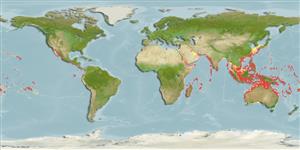ກຸ່ມປາກະດູກອ່ອນ (ເຊັ່ນ: ປາສະຫລາມ, ປາຜາໄລ) (sharks and rays) >
Myliobatiformes (Stingrays) >
Aetobatidae (Pacific eagle rays)
Etymology: Aetobatus: Greek, aetos = eagle + Greek, batis, batidos = a ray (Raja sp.) (Ref. 45335).
More on author: Kuhl.
Environment: milieu / climate zone / depth range / distribution range
ນິເວດວິທະຍາ
ສັດທະເລ; ນ້ຳກ່ອຍ ກ່ຽວກັບ (ຢູ່)ເທິງຊັ້ນພື້ນດິນໃນທະເລເປີດ; ລະດັບຄວາມເລິກ 1 - 100 m (Ref. 89467), usually 20 - 25 m (Ref. 89467). Tropical
Indo-Pacific: East Africa, including the Red Sea to Hawaiian Islands and French Polynesia.
Length at first maturity / ຂະໜາດ / ນ້ຳໜັກ / Age
Maturity: Lm 155.0, range 150 - 160 cm
Max length : 300 cm WD ຕົວຜູ້/ບໍ່ມີເພດ; (Ref. 114953); common length : 180 cm WD ຕົວຜູ້/ບໍ່ມີເພດ; (Ref. 6871); ນ້ຳໜັກສູງສຸດທີ່ເຄຍຈັດພີມມາ: 200.0 kg (Ref. 89467)
Short description
ສະລີລະວິທະຍາ | ການວັດແທກຮູບຮ່າງລັກສະນະພາຍນອກຂອງດິນ,ສັດ,ປາ…
This large species is distinguished by the following characters: dorsal surfaces with a dark greenish grey base coloration, variably white spotted, rarely ocellated; different NADH2 gene structure; relatively long tail with mean total length 281% DW, mean anterior cloaca to tail tip 230.2% DW; stinging spines relatively long with mean length of first spine 9.7%DW; teeth plates are in a single row, those in the lower jaw chevron-shaped; pectoral fin radials about 102-116, excluding proterygial radials anterior of eyes; 99-101 total vertebral centra, including synarcual (Ref. 84291).
Found in coastal waters (Ref. 45255), including estuarine habitats (Ref. 89467). Can grow over 3 m disc width and up to 880 cm total length if the long tail is undamaged (Ref. 30573). Feeds mainly on hard-shelled bottom-dwelling invertebrates such as hermit crabs, whelks, oysters, clams and large molluscs (Ref. 9862, 114953), crustraceans, worms, octopuses and fishes (Ref. 89467). Ovoviviparous (Ref. 50449). Size at maturity for males 100-130 cm WD, females ca. 150-160 cm WD and size at birth highly variable 18 cm to at least 50 cm WD. Females produce litters up to 10 pups, usually 4 or less (Ref. 114953). Common catch of the demersal tangle net, bottom trawl, inshore gillnet and, to a lesser extent, demersal longline fisheries. Utilized for its meat and cartilage (Ref. 58048). Tail used as a decorative item (Ref. 27550). Flesh edible (Ref. 30573).
Life cycle and mating behavior
ການຈະເລີນເຕັມໄວ | ການສືບພັນ | ການວາງໄຂ່ | ໄຂ່ | ຄວາມດົກຂອງໄຂ່ປາ | ຕົວອ່ອນ
Exhibit ovoviparity (aplacental viviparity), with embryos feeding initially on yolk, then receiving additional nourishment from the mother by indirect absorption of uterine fluid enriched with mucus, fat or protein through specialised structures (Ref. 50449).
White, W.T., P.R. Last, G.J.P. Naylor, K. Jensen and J.N. Caira, 2010. Clarification of Aetobatus ocellatus (Kuhl, 1823) as a valid species, and a comparison with Aetobatus narinari (Euphrasen, 1790) (Rajiformes: Myliobatidae). pp. 141-164. In P.R. Last, W.T. White and J.J. Pogonoski (eds). Descriptions of new sharks and rays from Borneo. CSIRO Marine and Atmospheric Research Paper no. 32. (Ref. 84291)
IUCN Red List Status (Ref. 130435)
Threat to humans
Traumatogenic (Ref. 4690)
Human uses
ຊະນິດປາທີ່ຖືກນຳໃຊ້ເຂົ້າໃນການຫາເພື່ອເປັນເກມກິລາ: ແມ່ນ
ຂໍ້ມູນຕື່ມອີກ
Age/Sizeການເຕີບໃຫຍ່Length-weightLength-lengthLength-frequenciesການວັດແທກຮູບຮ່າງລັກສະນະພາຍນອກຂອງດິນ,ສັດ,ປາ…ສະລີລະວິທະຍາຕົວອ່ອນການປ່ຽນແປງຂອງຕົວອ່ອນການທົດແທນທີ່ຄວາມອຸດົມສົມບູນBRUVS
ເອກະສານອ້າງອີງການລ້ຽງສັດນ້ຳຂໍ້ມູນການລ້ຽງສັດນ້ຳສາຍພັນກຳມະພັນElectrophoresesການຖ່າຍທອດທາງກຳມະພັນຈາກພໍ່ແມ່ຫາລູກພະຍາດການປຸງແຕ່ງNutrientsMass conversion
ເຄື່ອງມື
Special reports
Download XML
ແຫຼ່ງອີນເຕີເນັດ
Estimates based on models
Preferred temperature (Ref.
123201): 24.8 - 29, mean 28 °C (based on 194 cells).
Phylogenetic diversity index (Ref.
82804): PD
50 = 0.6250 [Uniqueness, from 0.5 = low to 2.0 = high].
Bayesian length-weight: a=0.01000 (0.00244 - 0.04107), b=3.04 (2.81 - 3.27), in cm total length, based on all LWR estimates for this body shape (Ref.
93245).
ຊັ້ນເຂດຮ້ອນ (Ref.
69278): 3.6 ±0.5 se; based on size and trophs of closest relatives
ຄວາມຢືດຢຸ່ນ (Ref.
120179): ຕຳ່, ປະຊາກອນຕຳ່ສຸດທີ່ໃຊ້ເວລາສອງເທົ່າ 4.5 - 14 ປີ (Fec assumed to be <100).
Fishing Vulnerability (Ref.
59153): Very high vulnerability (85 of 100).
Nutrients (Ref.
124155): Calcium = 11.2 [3.0, 58.1] mg/100g; Iron = 0.462 [0.106, 1.292] mg/100g; Protein = 21.2 [16.0, 26.3] %; Omega3 = 0.154 [0.046, 0.481] g/100g; Selenium = 63 [18, 210] μg/100g; VitaminA = 11.9 [4.0, 34.7] μg/100g; Zinc = 0.796 [0.376, 1.528] mg/100g (wet weight);
